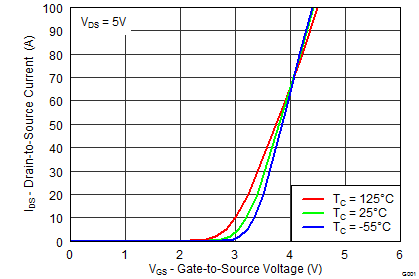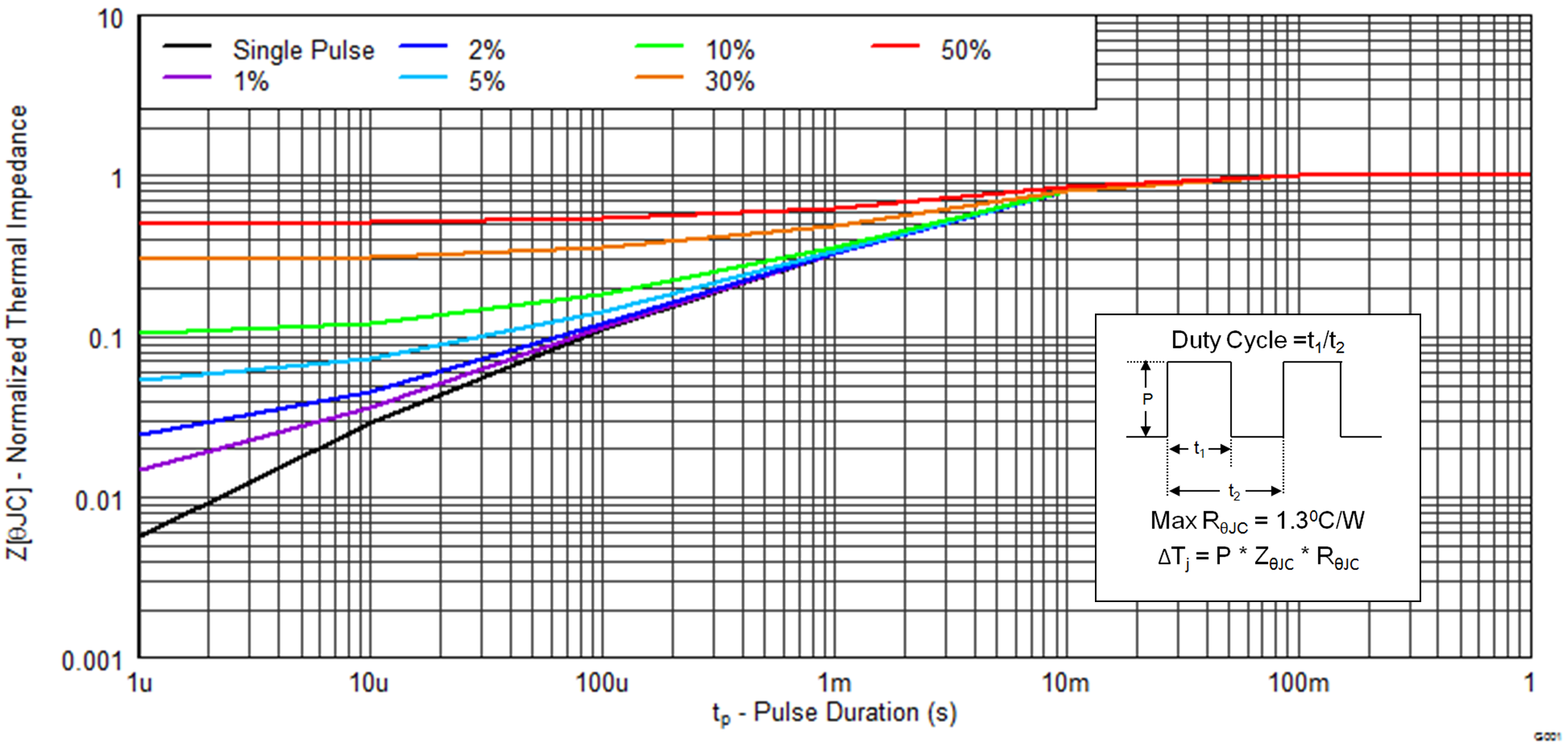SLPS444C July 2013 – January 2016 CSD18563Q5A
PRODUCTION DATA.
5 Specifications
5.1 Electrical Characteristics
(TA = 25°C unless otherwise stated)| PARAMETER | TEST CONDITIONS | MIN | TYP | MAX | UNIT | ||
|---|---|---|---|---|---|---|---|
| STATIC CHARACTERISTICS | |||||||
| BVDSS | Drain-to-source voltage | VGS = 0 V, ID = 250 μA | 60 | V | |||
| IDSS | Drain-to-source leakage current | VGS = 0 V, VDS = 48 V | 1 | μA | |||
| IGSS | Gate-to-source leakage current | VDS = 0 V, VGS = 20 V | 100 | nA | |||
| VGS(th) | Gate-to-source threshold voltage | VDS = VGS, ID = 250 μA | 1.7 | 2.0 | 2.4 | V | |
| RDS(on) | Drain-to-source on resistance | VGS = 4.5 V, ID = 18 A | 8.6 | 10.8 | mΩ | ||
| VGS = 10 V, ID = 18 A | 5.7 | 6.8 | mΩ | ||||
| gfs | Transconductance | VDS = 30 V, ID = 18 A | 60 | S | |||
| DYNAMIC CHARACTERISTICS | |||||||
| Ciss | Input capacitance | VGS = 0 V, VDS = 30 V, ƒ = 1 MHz | 1150 | 1500 | pF | ||
| Coss | Output capacitance | 280 | 364 | pF | |||
| Crss | Reverse transfer capacitance | 3.9 | 5.1 | pF | |||
| RG | Series gate resistance | 1.5 | 3.0 | Ω | |||
| Qg | Gate charge total (4.5 V) | VDS = 30 V, ID = 18 A | 7.3 | 9.5 | nC | ||
| Qg | Gate charge total (10 V) | 15 | 20 | ||||
| Qgd | Gate charge gate-to-drain | 2.9 | nC | ||||
| Qgs | Gate charge gate-to-source | 3.3 | nC | ||||
| Qg(th) | Gate charge at Vth | 2.3 | nC | ||||
| Qoss | Output charge | VDS = 30 V, VGS = 0 V | 36 | nC | |||
| td(on) | Turn on delay time | VDS = 30 V, VGS = 10 V, IDS = 18 A, RG = 0 Ω | 3.2 | ns | |||
| tr | Rise time | 6.3 | ns | ||||
| td(off) | Turn off delay time | 11.4 | ns | ||||
| tf | Fall time | 1.7 | ns | ||||
| DIODE CHARACTERISTICS | |||||||
| VSD | Diode forward voltage | ISD = 18 A, VGS = 0 V | 0.8 | 1 | V | ||
| Qrr | Reverse recovery charge | VDS= 30 V, IF = 18 A, di/dt = 300 A/μs | 63 | nC | |||
| trr | Reverse recovery time | 49 | ns | ||||
5.2 Thermal Information
(TA = 25°C unless otherwise stated)| THERMAL METRIC | MIN | TYP | MAX | UNIT | |
|---|---|---|---|---|---|
| RθJC | Junction-to-case thermal resistance(1) | 1.3 | °C/W | ||
| RθJA | Junction-to-ambient thermal resistance(1)(2) | 50 | |||
(1) RθJC is determined with the device mounted on a 1 inch2 (6.45 cm2), 2 oz. (0.071 mm thick) Cu pad on a 1.5 inch × 1.5 inch (3.81 cm × 3.81 cm), 0.06 inch (1.52 mm) thick FR4 PCB. RθJC is specified by design, whereas RθJA is determined by the user’s board design.
(2) Device mounted on FR4 material with 1 inch2 (6.45 cm2), 2 oz. (0.071 mm thick) Cu.
 |
Max RθJA = 50°C/W when mounted on 1 inch2 (6.45 cm2) of 2 oz. (0.071 mm thick) Cu. |
 |
Max RθJA = 125°C/W when mounted on a minimum pad area of 2 oz. (0.071 mm thick) Cu. |
5.3 Typical MOSFET Characteristics
(TA = 25°C unless otherwise stated)










